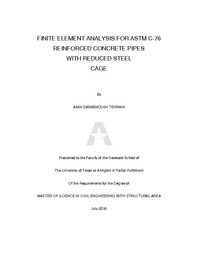
ATTENTION: The works hosted here are being migrated to a new repository that will consolidate resources, improve discoverability, and better show UTA's research impact on the global community. We will update authors as the migration progresses. Please see MavMatrix for more information.
Show simple item record
| dc.contributor.advisor | Abolmaali, Ali | |
| dc.creator | Darabnoush Tehrani, Amin | |
| dc.date.accessioned | 2016-10-25T20:30:06Z | |
| dc.date.available | 2016-10-25T20:30:06Z | |
| dc.date.created | 2016-08 | |
| dc.date.issued | 2016-09-13 | |
| dc.date.submitted | August 2016 | |
| dc.identifier.uri | http://hdl.handle.net/10106/26164 | |
| dc.description.abstract | Reinforced concrete pipes (RCP) are composite pipes which have been widely used in the industry for more than ten decades. They are generally used for sewerage, water drainage, and industrial waste water.
There are two methods for designing the RCP so that it will bear the soil weight and the live load on it: Indirect design (ID) and direct design (DD) methods. ASTM C76 (1) classifies pipes into five categories. The five categories of pipes have been classified in order of ascending pipe diameter with their required load and reinforcement’s area. Typically, there are two reinforcement types: circumferential and longitudinal. Circumferential reinforcement is placed in two layers in the thickness of the pipe and the longitudinal reinforcements are placed around the circumferential reinforcements. All these reinforcements are placed in one layer, also known as cages. The task of placing two cages of reinforcement is not only tedious but also time consuming, expensive and sometimes unnecessary, especially for pipe classes III, IV and V.
In this study, a three dimensional non-linear finite element modeling has been generated by using Abacus, Version 6.14-3, a program which is well known for non-linear finite element analysis, to simulate real pipe behavior for implementation of single cage instead of double cages reinforcements. Simulations were generated for classes III, IV and V with pipe diameters of 24, 36, 48, 60 and 72 in. Pipes were modeled by using three different single-cage reinforcement locations, in addition to the original double cage concrete pipe. After which a total of 80 simulations were conducted in order to compare the difference between the single and double cage behavior.
In order to verify the simulations, three ASTM standard Three Edge Bearing tests were performed. Pipes were selected and tested according to ASTM C76 and ASTM C497 standards specifications.
The study showed one cage of reinforcements in some pipes, satisfies all the ASTM requirements. Thereby making it possible for manufacturers to produce reinforced concrete pipes with a smaller amount of steel reinforcements per foot. | |
| dc.format.mimetype | application/pdf | |
| dc.language.iso | en_US | |
| dc.subject | Reinforced concrete pipes | |
| dc.subject | Reinforcement cage reduction | |
| dc.title | FINITE ELEMENT ANALYSIS FOR ASTM C-76 REINFORCED CONCRETE PIPES WITH REDUCED STEEL CAGE | |
| dc.type | Thesis | |
| dc.degree.department | Civil Engineering | |
| dc.degree.name | Master of Science in Civil Engineering | |
| dc.date.updated | 2016-10-25T20:32:13Z | |
| thesis.degree.department | Civil Engineering | |
| thesis.degree.grantor | The University of Texas at Arlington | |
| thesis.degree.level | Masters | |
| thesis.degree.name | Master of Science in Civil Engineering | |
| dc.type.material | text | |
Files in this item
- Name:
- DARABNOUSHTEHRANI-THESIS-2016.pdf
- Size:
- 8.439Mb
- Format:
- PDF
This item appears in the following Collection(s)
Show simple item record


